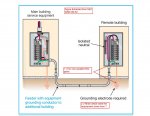
Two questions about the Exhibit from the NEC 2008 handbook,
The remote building is attached to the main building service ground bar with the egc in the same conduit with the feeder cables. It has also seperate grounding electrode in the remote building. So we have two ground paths totally and in a case of fault, most of the current will use the low impedance path which would be the grounding electrode in the remote building.
The Exhibit notes the grounding electrode required but could not exactly point the article.
Any help will be appreciated.

